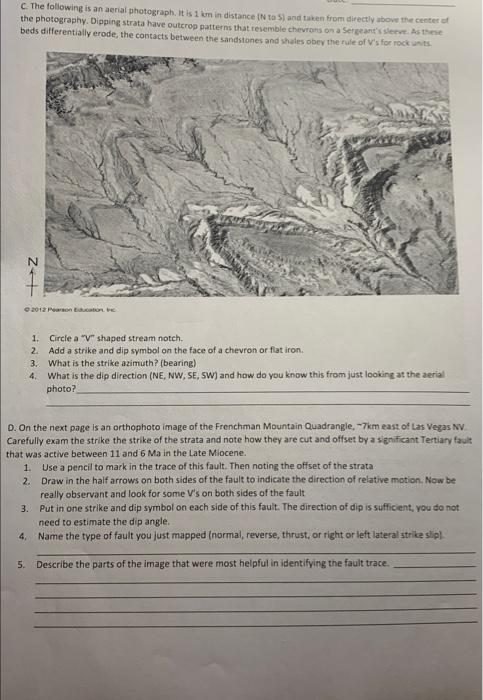Answered step by step
Verified Expert Solution
Question
1 Approved Answer
plz solve fast. C. The following is an aerial photograph. It is 1km in distance (Nv ta S) and tuken from directly above the cestet
plz solve fast. 
C. The following is an aerial photograph. It is 1km in distance (Nv ta S) and tuken from directly above the cestet of the photography. Dipping strata have outcrop patterns that resemble chevrans on a Sergeantis slecte. As thene, beds differentially erode, the contacts between the sandstones and shales obey ue rue of V's for rock unts: 1. Circle a " V " shaped stream notch. 2. Add a strike and dip symbol on the face of a chevron or flat iron. 3. What is the strike azimuth? (bearing) 4. What is the dip direction (NE, NW, SE, SW) and how do you know this from just looking at the aerial photo? D. On the next page is an orthophoto image of the Frenchman Mountain Quadrangle, 77km east of Las Vegas NV Carefully exam the strike the strike of the strata and note how they are cut and offset by a significant Tertiary fault that was active between 11 and 6Ma in the Late Miocene. 1. Use a pencil to mark in the trace of this fault. Then noting the offset of the strata: 2. Draw in the half arrows on both sides of the fault to indicate the direction of relative motion. Now be really observant and look for some V's on both sides of the fault 3. Put in one strike and dip symbol on each side of this fault. The direction of dip is sufficient, you do not need to estimate the dip angle. 4. Name the type of fault you just mapped (normal, reverse, thrust, or right or left lateral strice slip)- 5. Describe the parts of the image that were most helpful in identifying the fault trace. C. The following is an aerial photograph. It is 1km in distance (Nv ta S) and tuken from directly above the cestet of the photography. Dipping strata have outcrop patterns that resemble chevrans on a Sergeantis slecte. As thene, beds differentially erode, the contacts between the sandstones and shales obey ue rue of V's for rock unts: 1. Circle a " V " shaped stream notch. 2. Add a strike and dip symbol on the face of a chevron or flat iron. 3. What is the strike azimuth? (bearing) 4. What is the dip direction (NE, NW, SE, SW) and how do you know this from just looking at the aerial photo? D. On the next page is an orthophoto image of the Frenchman Mountain Quadrangle, 77km east of Las Vegas NV Carefully exam the strike the strike of the strata and note how they are cut and offset by a significant Tertiary fault that was active between 11 and 6Ma in the Late Miocene. 1. Use a pencil to mark in the trace of this fault. Then noting the offset of the strata: 2. Draw in the half arrows on both sides of the fault to indicate the direction of relative motion. Now be really observant and look for some V's on both sides of the fault 3. Put in one strike and dip symbol on each side of this fault. The direction of dip is sufficient, you do not need to estimate the dip angle. 4. Name the type of fault you just mapped (normal, reverse, thrust, or right or left lateral strice slip)- 5. Describe the parts of the image that were most helpful in identifying the fault trace 
Step by Step Solution
There are 3 Steps involved in it
Step: 1

Get Instant Access to Expert-Tailored Solutions
See step-by-step solutions with expert insights and AI powered tools for academic success
Step: 2

Step: 3

Ace Your Homework with AI
Get the answers you need in no time with our AI-driven, step-by-step assistance
Get Started


